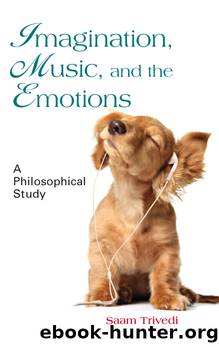Imagination, Music, and the Emotions by Trivedi Saam

Author:Trivedi, Saam
Language: eng
Format: epub
Publisher: State University of New York Press
Published: 2017-03-15T00:00:00+00:00
V
Imagination
V.1. Introduction: Different Kinds of Imaginings
In thinking of imagination in relation to music, it seems clear that the creative imagination is involved in such activities as musical composition and improvisation and also in performance as performers may often imagine auditorily how a certain passage or piece will sound if played at this tempo or at that one, or with these dynamics and articulation rather than those ones, and so on. Perhaps composers, in writing musical works, imagine musical forms, timbres, textures, and the like by creating images of these in their auditory imaginations, and then later often, even if not always, test their hypotheses about these images through actual music-making (Levinson 1992, 84â85). The same might hold true of improvisers in jazz and other oral traditions, such as Indian classical music, which call essentially for improvisation, though the auditory imagination must work much quicker here, since improvisers play or perform what they imagine, or some variant thereof, soon after imagining it, leaving aside what has been imagined prior to the commencement of the improvisatory performance.1
Be that as it may, before exploring the issue of how imagination applies to musical expressiveness, which will be done in the next chapter, we need to explore briefly the nature of imagination itself. Accordingly, I begin in section V.1 by briefly exploring different kinds of imaginings. Section V.2 discusses the important work on imagination by Brian OâShaughnessy, which I draw on presenting my imaginationist view of musical expressiveness both in this chapter and especially in chapter VI. In section V.3, I briefly discuss work on childrenâs imaginings by the psychologist Paul Harris and relate it to my imaginationism about musical expressiveness, while section V.4 deals with Gregory Currieâs influential work on the imagination. Section V.5 discusses the role of imagination in music perception, and also in musical culture.
So, what is it to imagine something? What is involved in imagination? Is there one, uniform sense of imagination involved in various imaginative activities? Or are there many different senses of imagination? If there are various senses of imagining, do they all apply to musical expressiveness? If so, do they all apply in the same way or to the same degree, or are there important differences in how they are involved in hearing music as expressive? I cannot address all these questions adequately in what follows, and no doubt there are also other questions that can be raised. But I hope at least to make a start here at addressing some of these questions that are seldom raised and addressed in the work done so far on musical expressiveness by various philosophers.
We imagine things in a variety of ways, not all of which are highly conscious or foregrounded (see Ryle 1949, chapter 8; Walton 1990; Kieran and Lopes 2003). What follows is a short, nonexhaustive list of different kinds of imaginings.
The first notion of imagination that comes readily to mind is that imagination involves forming mental images in the sense of visualizing things or scenes or events or things not present, as when one tries to picture an ice-cream cone in oneâs mind.
Download
This site does not store any files on its server. We only index and link to content provided by other sites. Please contact the content providers to delete copyright contents if any and email us, we'll remove relevant links or contents immediately.
| Appreciation | Blank Sheet Music |
| Composition | Conducting |
| Exercises | Instruction & Study |
| Lyrics | MIDI, Mixers, etc |
| Philosophy & Social Aspects | Songwriting |
| Techniques | Theory |
| Vocal |
The Goal (Off-Campus #4) by Elle Kennedy(13542)
Kathy Andrews Collection by Kathy Andrews(11726)
Diary of a Player by Brad Paisley(7487)
What Does This Button Do? by Bruce Dickinson(6133)
Assassin’s Fate by Robin Hobb(6126)
Big Little Lies by Liane Moriarty(5699)
Altered Sensations by David Pantalony(5043)
Pale Blue Dot by Carl Sagan(4907)
Sticky Fingers by Joe Hagan(4100)
The Death of the Heart by Elizabeth Bowen(3551)
The Heroin Diaries by Nikki Sixx(3492)
Beneath These Shadows by Meghan March(3261)
Confessions of a Video Vixen by Karrine Steffans(3240)
How Music Works by David Byrne(3184)
The Help by Kathryn Stockett(3082)
Jam by Jam (epub)(3020)
Harry Potter 4 - Harry Potter and The Goblet of Fire by J.K.Rowling(2984)
Strange Fascination: David Bowie: The Definitive Story by David Buckley(2797)
Petty: The Biography by Warren Zanes(2697)
